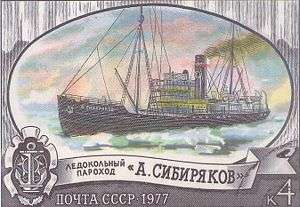A. Sibiryakov (icebreaker)
 A. Sibiryakov in a Soviet postage stamp | |
| History | |
|---|---|
| Name: | A. Sibiryakov |
| Owner: | Glavsevmorput, Soviet Union |
| Port of registry: | Archangelsk |
| Ordered: | 1908 |
| Builder: | D & W Henderson Ltd, Glasgow |
| Yard number: | No 464 |
| Laid down: | 23 November 1908 |
| Launched: | 1909 as Bellaventure |
| Completed: | 1909 |
| Acquired: | 1916 |
| Fate: | sunk by German cruiser Admiral Scheer 24 August 1942 |
| General characteristics | |
| Type: | Icebreaker |
| Tonnage: | 1,383 tons |
| Length: | 76.5 m (251 ft) |
| Beam: | 10.8 m (35 ft) |
| Draught: | 6 m (20 ft) |
| Ice class: | icebreaker |
| Installed power: | 2,360 hp (1,760 kW) |
| Propulsion: | 1 shaft steam engine, 2 boilers |
| Speed: | 13 knots (24 km/h; 15 mph) |
| Crew: | 104 |
| Notes: | armed with a single 4 in (102 mm) gun in 1942 |
A. Sibiryakov (Russian Александр Сибиряков) was a Soviet icebreaker which was active in the Russian Arctic during the 1930s. She was built in 1909 in Glasgow and was originally the Newfoundland sealing steamer Bellaventure. After being purchased by Russia in 1916, she was renamed A. Sibiryakov. Her Russian name was chosen in honour of Aleksandr Mikhaylovich Sibiryakov, an Imperial Russian gold mine proprietor. Sibiryakov financed explorations to Siberia, such as Adolf Erik Nordenskiöld's, and also took part in some expeditions of his own.
Service before war
A. Sibiryakov made the first successful crossing of the Northern Sea Route in a single navigation without wintering. This historic voyage, which had been Mikhail Lomonosov's dream, was organized by the All-Union Arctic Institute (presently known as the Arctic and Antarctic Research Institute).
A. Sibiryakov sailed on 28 June 1932 from the Krasny (previously Sobornoy) docks in Arkhangelsk, crossed the Kara Sea and chose a northern, unexplored way around Severnaya Zemlya to the Laptev Sea. In September, after calling at Tiksi and the mouth of the Kolyma, the propeller shaft broke and the icebreaker drifted for 11 days. However, A. Sibiryakov crossed the Chukchi Sea using improvised sails and arrived in the Bering Strait in October. A. Sibiryakov reached the Japanese port of Yokohama after 65 days, having covered more than 2,500 miles (4,000 km) in the Arctic seas. This was regarded as a heroic feat of Soviet polar seamen and Chief of Expedition Otto Schmidt and Captain Vladimir Voronin were received with many honors at their return to Russia.
Service during war and sinking
A. Sibiryakov continued in service until World War II under the command of Captain Anatoli Kacharava. On 25 August 1942 she was sunk after an unequal fight with Kriegsmarine heavy cruiser Admiral Scheer off the northwestern shores of Russky Island in the Nordenskiöld Archipelago during Operation Wunderland. A. Sibiryakov was armed only with several 76 mm (3 in) and 45 mm (2 in) guns and was no match for the heavy cruiser, mounting 280 mm (11 in) main guns. However, radio transmission from A. Sibiryakov before and during 1-hour battle alerted east and west bound Russian convoys, allowing them to avoid the area. Most members of A. Sibiryakov's crew and civilians died in battle or went down with the ship. 22, including severely wounded Captain Kacharava, were captured by the Germans. Only one sailor, stoker Pavel Vavilov, managed to reach Beluha Island and was picked up by a Russian ship 34 or 35 days later. In total only 15 crew members survived the war. Soviet sources say 79 killed, 19 taken as prisoner-of-war of whom 13 survived.
When the Finnish icebreaker Jääkarhu was handed over to the Soviet Union, it was renamed Sibiryakov.
References
- Armstrong, T., The Russians in the Arctic, London, 1958.
- Early Soviet Exploration
- History of Russian Arctic Exploration
- German Naval Warfare in 1942
Coordinates: 76°00′N 91°31′E / 76.000°N 91.517°E